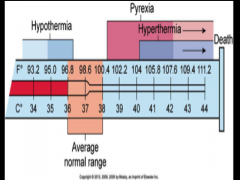![]()
![]()
![]()
Use LEFT and RIGHT arrow keys to navigate between flashcards;
Use UP and DOWN arrow keys to flip the card;
H to show hint;
A reads text to speech;
70 Cards in this Set
- Front
- Back
|
Vital signs used to |
measure patients condition ID problems Evaluate response to intervention |
|
|
When to do you take vitals |
Admission Routine schedule Before after procedures Before administering meds which affect VS When a patient reports feeling different |
|
|
Normal Vitals - TPR B/P |
Temp 96.8 to 100.4
Pulse 60 to 100 Respirations 12 to 20 B/P systolic < 120, diastolic <80 Pulse pressure 30 to 50 |
|

|
temperate ranges |
|
|
Rectal temperature problems |
Vagal response for patients with cardiac repsonse |
|
|
Neural Regulation of Body temp |
Hypothalamus |
|
|
Vascular regulation of body temp |
Vasoconstriction/Vasodilation |
|
|
Burn patients are high risk for |
temperature loss |
|
|
Heat production |
Basal metabolic rate increased thyroid hormones muscle movements shivering |
|
|
Heat Loss occurs from the following |
Radiation, convection, conduction, evaporation |
|
|
Conduction |
direct contact heat xfer |
|
|
Convection |
air movement heat xfer |
|
|
Radiation |
Heat xfer from indirect contact. i.e cold rooms |
|
|
evaporation |
heat xfer or loss from liquid to gas change |
|
|
Infants can not |
shiver |
|
|
Febrile seizure occur |
seizure due to high fever (6 months to 3 yrs) |
|
|
Mild elevation of temp |
up to 102.2 |
|
|
Pryogens |
trigger immune response part of immune system |
|
|
Infants temp that is significant |
>100.4 |
|
|
Brachycardia |
<60 BPM |
|
|
Tachycardia |
>100 |
|
|
stroke volume |
60-70mL/beat |
|
|
SV x HR = |
CO cardiac output |
|
|
Normal Cardiac output |
4-6 L/min |
|
|
SA node |
normal pacemaker 60-80 BPM |
|
|
AV node |
backup pacemaker 40-60 BPM |
|
|
Location of pulses |
Carotid Brachial Apical Brachial Radial Femoral Posterior Tibial Dorsalis Pedis |
|
|
Carotid pulse |
access one at time |
|
|
Apical pulse |
auscultate used for irregular HR or prior to administering meds |
|
|
Femoral pulse |
shock or arrest |
|
|
Pulse Character |
1 - diminished 2 - normal 3 - strong 4 - bounding |
|
|
Pulse deficit indicate |
abnormal heart rhythms |
|
|
Factors that affect Pulse |
age exercise temperature emotions drugs Postural changes O2 sat Pain |
|
|
Ventilation |
movement of gases of CO2 and O2
|
|
|
Diffusion |
gas exchange |
|
|
Perfusion |
delivery of O2 |
|
|
Hypoxemia |
Low O2 in the blood |
|
|
early signs of Hypoxemia |
restlessness, confusion, anxiety |
|
|
late stages of hypoxemia |
cyanosis, tachycardia, bradycardia |
|
|
Eupnea |
Normal breathing |
|
|
Bradypnea |
<12 |
|
|
Tachypnea |
>20 |
|
|
Apnea |
no respiration |
|
|
Dyspnea |
difficulty breathing |
|
|
Hyperventilation |
fast, excessive breathing |
|
|
Hypo-ventilation |
slow, breathing |
|
|
Cheyne Stokes |
end of life breathing, set pattern, gradual increase of breathing, apnea, then restarts |
|
|
Kussmaul |
associated with DKA (hyperventilation) |
|
|
O2 saturation normal |
>95% |
|
|
sites to access to check O2 saturation |
finger, toes, forehead, earlobe |
|
|
what affects accuracy of O2 sat |
sweating, cold, nail polish, compromised vascular system, edema |
|
|
critical report for O2 when |
<90% |
|
|
Systolic |
contraction of ventricles |
|
|
Diastolic |
heart at rest |
|
|
Pulse pressure |
difference between systolic and diastolic 30 - 50 mm HG (normal) |
|
|
Blood pressure depends upon |
Cardiac Output Peripheral vascular resistence (afterload) Blood volume (preload) Viscosity - (hematocrit) Elasticity |
|
|
Viscosity - High |
dehydration = low B/P |
|
|
Viscosity - low |
Edema - High B/P |
|
|
Do not perform B/P on arms with |
Shunt Mastectomy trauma IV |
|
|
MAP |
mean aterial pressure |
|
|
Mean Arterial pressure |
average blood pressure in an individual. It is defined as the average arterial pressure during a single cardiac cycle |
|
|
Orthostatic (Postural) Hypo-tension |
Changes in B/P due to position changes |
|
|
SX of Orthostatic (Postural) Hypo-tension |
weakness, dizziness |
|
|
Orthostatic signs from supine to standing position |
Decreasing SBP of 20 mm Hg or more Decreasing DBP of 10 mm Hg or more Increasing HR > 20 beats/min |
|
|
when measuring B/P cuff should be what size to the arm |
40% greater |
|
|
first sound you hear during auscultation when checking B/P |
systolic |
|
|
Last sound you hear during auscultation B/P |
diastolic |
|
|
False high reading B/P |
small cuff deflating to slow arm below heart |
|
|
False low reading B/P |
cuff to big deflate to fast arm above heart |
|
|
don;t use electronic measure of BP |
irregular heart rate vascular obstruction shivering seizures excessive tumors SBP<90 |

